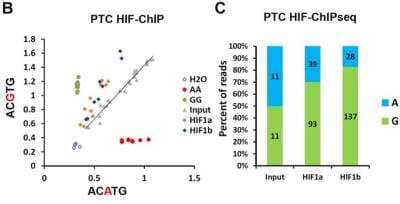ARNT/HIF-1 beta Antibody Pack
Novus Biologicals, part of Bio-Techne | Catalog # NB100-982

Key Product Details
Species
Human, Mouse, Rat, Bovine, Ferret, Sheep
Applications
Chromatin Immunoprecipitation, Immunocytochemistry/ Immunofluorescence, Immunohistochemistry, Immunoprecipitation, Western Blot
Product Summary for ARNT/HIF-1 beta Antibody Pack
This pack contains 1 vial of each: NB100-110 (0.1 mL) and NB100-124 (0.1 mL).
Product Specifications
Specificity
See individual datasheets for specificity notes regarding ARNT/HIF-1 beta antibody pack..
Application Notes
See individual datasheets of components for their validated applications
Reactivity Notes
See individual datasheets of components for their validated species
Scientific Data Images for ARNT/HIF-1 beta Antibody Pack
Western Blot: ARNT/HIF-1 beta Antibody Pack [NB100-982]
Western Blot: ARNT/HIF-1 beta Antibody Pack [NB100-982] - Analysis of ARNT/HIF-1 beta using ARNT/HIF-1 beta antibody [NB100-110] from ARNT/HIF-1 beta antibody pack [NB100-982] in MCF7 whole cell lysate. Theoretical molecular weight of ARNT/HIF-1 beta is 86.6 kDa, observed molecular weight ~90 kDa.Immunohistochemistry: ARNT/HIF-1 beta Antibody Pack [NB100-982]
Immunohistochemistry: ARNT/HIF-1 beta Antibody Pack [NB100-982] - Staining of skin, epidermis using ARNT/HIF-1 beta antibody [NB100-110] from the ARNT/HIF-1 beta antibody pack [NB100-982].
Chromatin Immunoprecipitation: ARNT/HIF-1 beta Antibody Pack [NB100-982] - Allele specific HIF-binding at the rs12814794 associated enhancer. B) Allele-specific qPCR for rs12814794 from DNA fragments isolated in HIF-ChIP experiments (HIF-1A and ARNT/HIF-1 beta) or input DNA from primary renal tubular cells (PTC, n = 4 individuals). DNA from individuals homozygous for the AA or GG genotype were used as positive controls. C) Quantification of the two different alleles (A or G) at rs12814794 in the ChIP-seq reads from HIF-1A and ARNT/HIF-1 beta antibody [NB100-110] immunoprecipitations (PTC #1 Fig 3). Image collected and cropped by CiteAb from the following publication (//doi.org/10.1371/journal.pgen.1006872) licensed under a CC-BY license.
Kit Contents for ARNT/HIF-1 beta Antibody Pack
Formulation, Preparation, and Storage
Concentration
Concentration of individual antibodies may be found on the vial label. If unlisted please contact technical services.
Shipping
The product is shipped with polar packs. Upon receipt, store it immediately at the temperature recommended below.
Storage
Store at 4C. Do not freeze.
Background: ARNT/HIF-1 beta
ARNT has an important role in two specific signaling pathways - the aryl hydrocarbon receptor (AhR) and the hypoxia inducible factor (HIF) pathway (1). In the AhR pathway, AhR in the cytosol is typically inactive and bound to heat shock protein 90 (hsp90) (3). Upon activation and ligand binding by environmental pollutants such as dioxins, AhR is translocated to the nucleus, dissociates from hsp90, and dimerizes with ARNT, leading to binding to response elements and expression of target genes including monooxygenases (1, 3). In the HIF pathway, under hypoxia (low oxygen) conditions prolylhydroxylase domain (PHD) enzymes and factor inhibiting HIF (FIH) are inhibited. HIF-1 alpha (or HIF-2 alpha) accumulates and is transported to the nucleus where it heterodimerizes with ARNT, allowing for binding to target gene's hypoxia response element (HRE), recruitment of coactivators, and transcription (1, 3). HIF-induced gene transcription plays a large role in tumor progression by promoting invasion, metastasis, de-differentiation and altered metabolism, and angiogenesis (1). While HIF-1 alpha's stability is dependent upon oxygen conditions, HIF-1 beta is stable in both normoxia and hypoxia (1-3).
The bHLH-PAS family and ARNT have been linked with a variety of pathologies and diseases including cancer, metabolic diseases, autoimmune diseases, and psychiatric disorders (2). ARNT/AHR is expressed in the skin and its pathway activation enhances skin barrier function and epidermal terminal differentiation, thus AHR agonists are currently being used as therapeutics for atopic dermatitis and psoriasis (4). Accordingly, studies of Arnt-deficient mice show profound abnormalities in skin barrier function and keratinization (4). Additionally, studies suggest that ARNT plays an important role in diabetes and beta-cell function (5). Islets from patients with type 2 diabetes have a significantly decreased ARNT expression compared to glucose-tolerant control donors (5). Modulation and stimulation of the HIF pathway may be a potential therapeutic strategy for treating type 2 diabetes and metabolic syndrome (5).
Alternate names for ARNT/HIF-1 beta include aryl hydrocarbon receptor nuclear translocator, BHLHE2, class E basic helix-loop-helix protein 2, Dixon receptor nuclear translocator, Hypoxia-inducible factor 1-beta, nuclear translocator, and TANGO.
References
1. Mandl, M., & Depping, R. (2014). Hypoxia-inducible aryl hydrocarbon receptor nuclear translocator (ARNT) (HIF-1beta): is it a rare exception?. Molecular medicine (Cambridge, Mass.). https://doi.org/10.2119/molmed.2014.00032
2. Wu, D., & Rastinejad, F. (2017). Structural characterization of mammalian bHLH-PAS transcription factors. Current opinion in structural biology. https://doi.org/10.1016/j.sbi.2016.09.011
3. Esser, C., & Rannug, A. (2015). The aryl hydrocarbon receptor in barrier organ physiology, immunology, and toxicology. Pharmacological reviews.https://doi.org/10.1124/pr.114.009001
4. Furue, M., Hashimoto-Hachiya, A., & Tsuji, G. (2019). Aryl Hydrocarbon Receptor in Atopic Dermatitis and Psoriasis. International journal of molecular sciences. https://doi.org/10.3390/ijms20215424
5. Girgis, C. M., Cheng, K., Scott, C. H., & Gunton, J. E. (2012). Novel links between HIFs, type 2 diabetes, and metabolic syndrome. Trends in endocrinology and metabolism: TEM, https://doi.org/10.1016/j.tem.2012.05.003
Long Name
Aryl Hydrocarbon Receptor Nuclear Translocator
Alternate Names
HIF-1 beta, HIF1 beta, TANGO
Gene Symbol
ARNT
Additional ARNT/HIF-1 beta Products
Product Documents for ARNT/HIF-1 beta Antibody Pack
Product Specific Notices for ARNT/HIF-1 beta Antibody Pack
This product is for research use only and is not approved for use in humans or in clinical diagnosis. Antibody Packs are guaranteed for 1 year from date of receipt.
Loading...
Loading...
Loading...
Loading...
Loading...
![Immunohistochemistry: ARNT/HIF-1 beta Antibody Pack [NB100-982] Immunohistochemistry: ARNT/HIF-1 beta Antibody Pack [NB100-982]](https://resources.bio-techne.com/images/products/HIF-1-beta-Antibody-Pack-Immunohistochemistry-NB100-982-img0005.jpg)

![Western Blot: ARNT/HIF-1 beta Antibody Pack [NB100-982] Western Blot: ARNT/HIF-1 beta Antibody Pack [NB100-982]](https://resources.bio-techne.com/images/products/ARNT-HIF-1-beta-Antibody-Pack-Western-Blot-NB100-982-img0006.jpg)
![Western Blot: ARNT/HIF-1 beta Antibody Pack [NB100-982] Western Blot: ARNT/HIF-1 beta Antibody Pack [NB100-982]](https://resources.bio-techne.com/images/products/ARNT-HIF-1-beta-Antibody-Pack-Western-Blot-NB100-982-img0010.jpg)
![Western Blot: ARNT/HIF-1 beta Antibody Pack [NB100-982] Western Blot: ARNT/HIF-1 beta Antibody Pack [NB100-982]](https://resources.bio-techne.com/images/products/ARNT-HIF-1-beta-Antibody-Pack-Western-Blot-NB100-982-img0007.jpg)
![Immunohistochemistry: ARNT/HIF-1 beta Antibody Pack [NB100-982] Immunohistochemistry: ARNT/HIF-1 beta Antibody Pack [NB100-982]](https://resources.bio-techne.com/images/products/HIF-1-beta-Antibody-Pack-Immunohistochemistry-NB100-982-img0004.jpg)